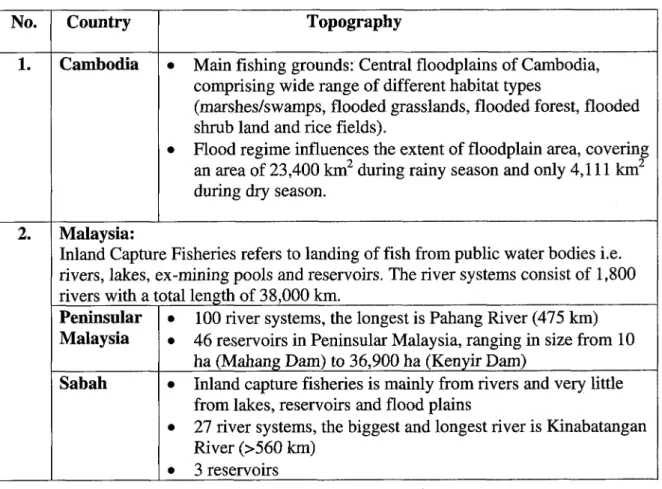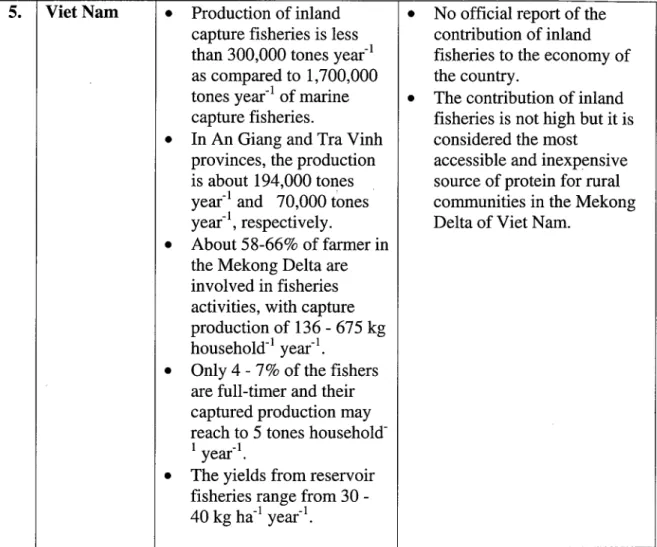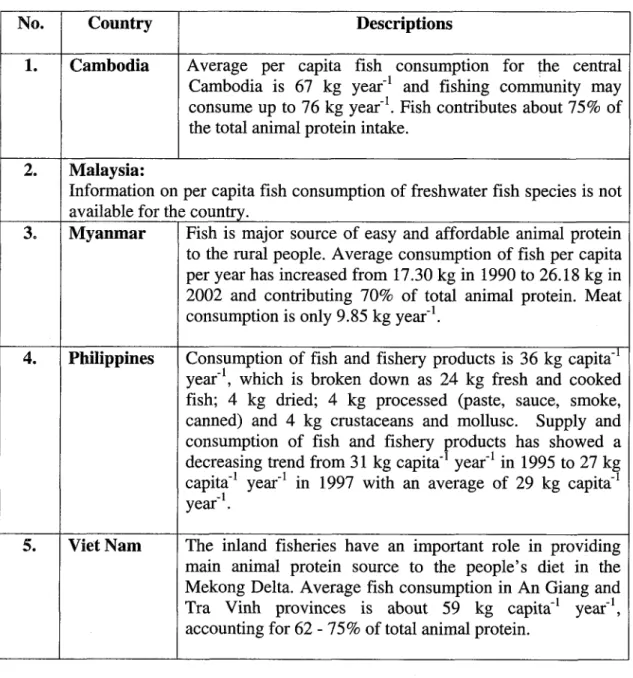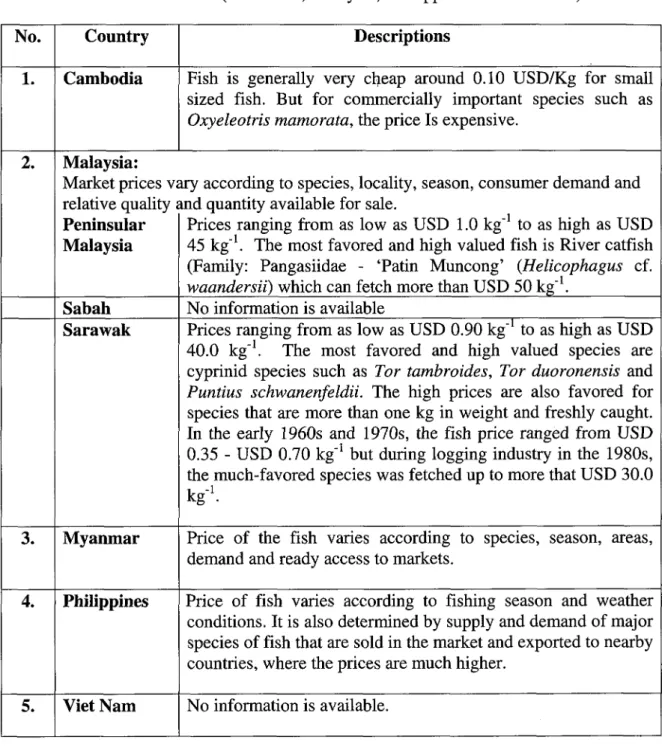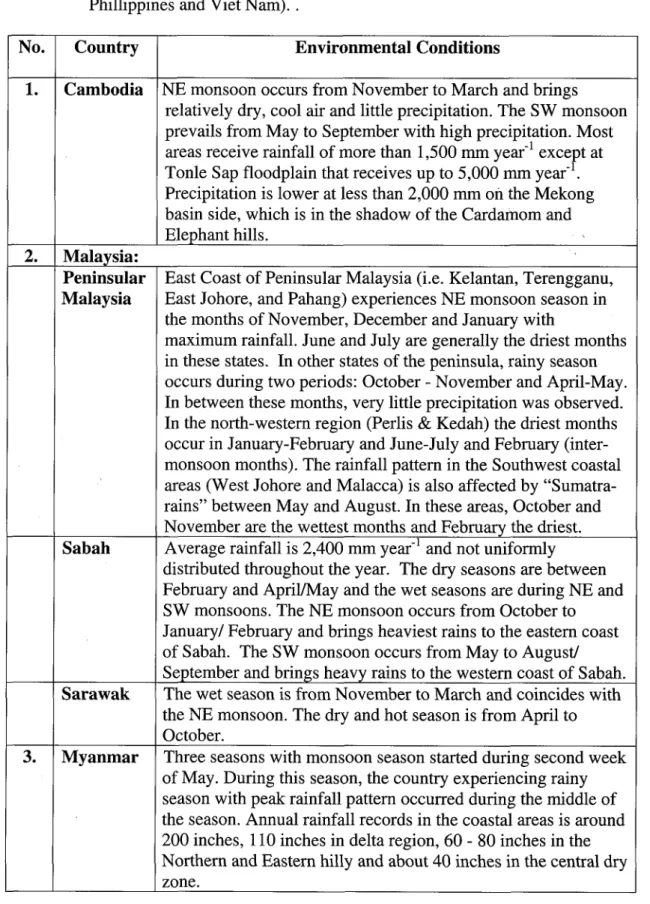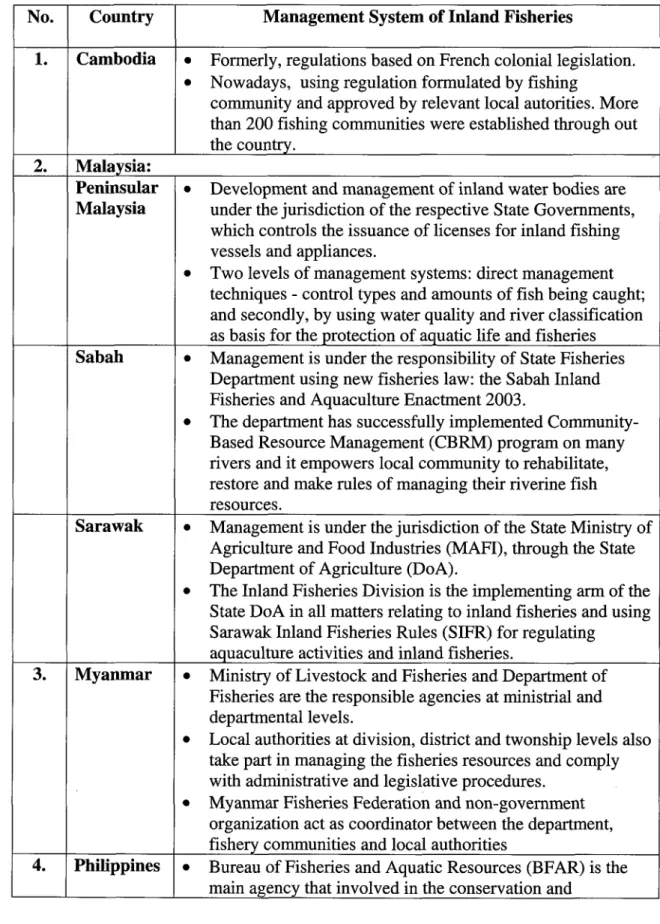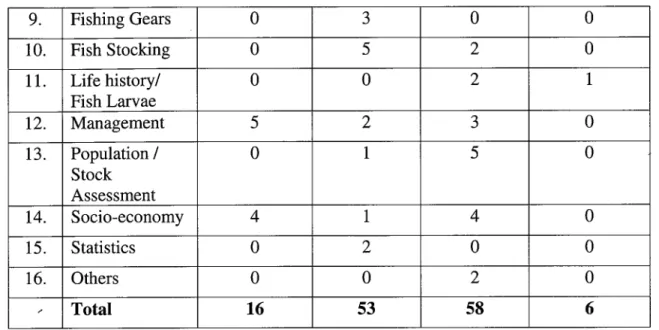Report of the First ASEAN Seafdec Regional Technical Consultation on Capture Fisheries Information Collection in ASEAN Countries. Report of the First ASEAN Seafdec Regional Technical Consultation on Capture Fisheries Information Collection in ASEAN Countries.
Biodiversity,
PILOT PROJECT PROPOSALS BY MEMBER COUNTRIES
The project must address the priority concern of the country and be manageable within the budgetary and personnel capacity of the countries and project duration;. Collection of information on fishing gear is useful, but in view of the wide variety of gear used, the required level of description of fishing gear should be considered before cataloguing; and.
Chief, Sub Directorate of Data Directorate of Fisheries Resources Statistics Director General of Capture Fisheries Ministry of Maritime Affairs and Fisheries Jalan Harsono, RM No.
REGIONAL TECHNICAL CONSULTATION ON INFORMATION GATHERING FOR
COUNTRIES
The significant role of inland fisheries in the socio-economics of rural areas in the countries of Southeast Asia is widely recognised. Now the hard work begins as we take steps to address the challenges of achieving sustainable fisheries and food security in the region.
PROVISIONAL AGENDA AND TIME TABLE
REGIONAL TECHNICAL CONSULTATION ON INFORMATION COLLECTION FOR INLAND FISHERIES IN ASEAN.
PROVISIONAL AGENDA AND TIMETABLE
August 2003 (Monday) 0830 - 0845 Registration
Presentation on work plan for the project: Information collection for inland fisheries catch from 2003 to 2005 by MFRDMD.
REVIEW OF CURRENT INFORMATION ON INLAND CAPTURE FISHERIES IN ASEAN
M AHYAM M OHAM M AD ISA AND JAM ALUDDIN IBRAHIM
REVIEW OF CURRENT INFORMATION ON INLAND CAPTURE FISHERIES IN ASEAN COUNTRIES
Introduction
General Description of Inland Fisheries
Malaysia
The river systems and tributaries cover an area of 737,800 km2 and contribute to eight major basins. Viet Nam • The inland fishery in southern Vietnam consists of the large Mekong River Delta, with an area of approx.
Viet Nam • Inland capture fisheries in South Viet Nam consists of large delta of the Mekong River, with an area of approximately
- Inland Fisheries Resources
- Status and Contribution of Inland Capture Fisheries to Economy
The systems make a significant contribution to inland fisheries, followed by lakes (mainly ponds), floodplains and artificial reservoirs. Fishing production in inland waters has increased since 1999 and in 2001 amounted to 3446 tonnes.
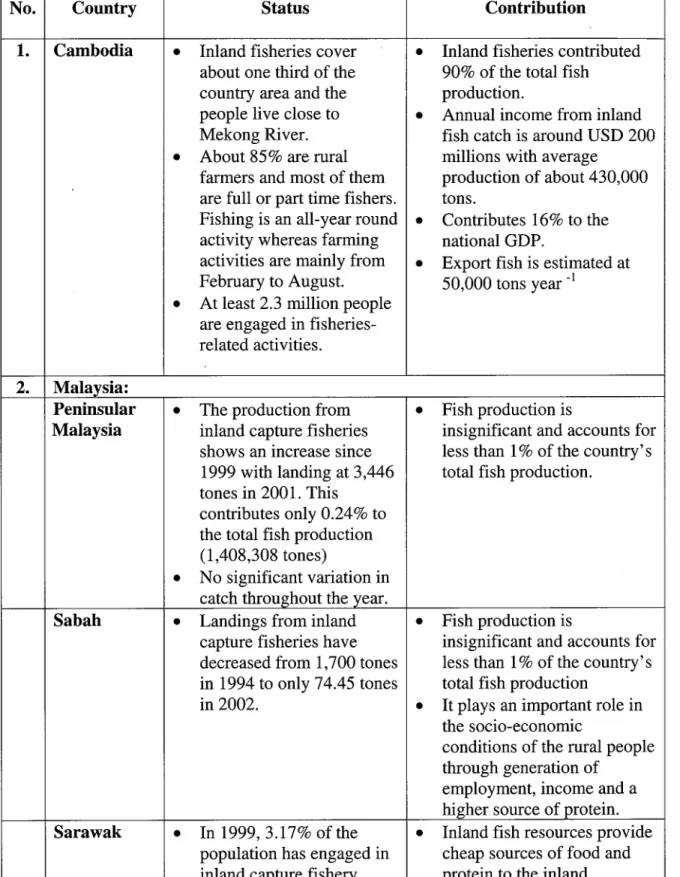
Myanmar • Production from freshwater fisheries
In the Batang Ai HEP reservoir, the catch was highest in 1985 (the first year of retention) with an average of 270 kg of fish per day.
Philippines • Inland fisheries production is in decreasing trend
Viet Nam • Production of inland capture fisheries is less
- Species Compositions
Common species caught are catfish, cyprinids, snakehead, carp, freshwater prawns, marble goby, eel, Wallago spp. The main commercially important freshwater species caught in the rainy season are giant freshwater shrimp (Macrobrachium rosenbergii), catfish (Pangasius spp.), Wallago maculatus, Mystus sp., and in the dry season are Puntius spp.,.
Myanmar Common species caught are catfish, snakehead, perch, carps, freshwater prawns, goby and eels
A total of 249 species of freshwater fish have been recorded from estuaries to the interior of Sarawak and Brunei. For example, Tor species are commonly found in the upper reaches of the river, Mystus spp.
Philippines Common species caught are silver perch, white goby, ornate
- Fishing Gears
Medium-scale (artificial) fisheries - use about 200 fishing gears in open access area and during open season. Myanmar Common fishing tools are fishing lines and other hook fishing, drift and float nets, regular (straight) fixed nets, cast and trap nets, pushers,.
Myanmar Common fishing gears are angling and other hook fishing, drift and float nets, plain (straight) fixed nets, casting and drop nets, pushing,
Family fisheries (subsistence) - operating in open access areas throughout the year, during the closed fishing season in restricted access areas and also in flooded rice fields. Sabah Common fishing gear is gill net, drift net, portable trap, hook and line and use of destructive fishing methods such as electrofishing and poison (rotenone) fishing.
Philippines Common fishing gears are gillnet, fish trap, longline, cast net and snail dredge for freshwater snails
- Per Capita Fish consumption
Cambodia The average fish consumption per per capita in central Cambodia is 67 kg yr-1, and the fishing community can consume up to 76 kg yr-1. Information on per capita fish consumption of freshwater fish species is not available for the country.
- Fish Price
Myanmar fish is a major source of simple and affordable animal protein for rural people. The most popular and highly valued fish is the river catfish (Family: Pangasiidae - 'Patin Muncong' (Helicophagus cf. waandersii), which can fetch more than USD 50 kg-1.
Myanmar Price of the fish varies according to species, season, areas, demand and ready access to markets
The most preferred and highly valued species are cyprinid species such as Tor tambroides, Tor duoronensis and Puntius schwanenfeldii. Myanmar Fish price varies by species, season, areas, demand and ease of access to markets.
Philippines Price of fish varies according to fishing season and weather conditions. It is also determined by supply and demand of major
Market prices vary according to species, locality, season, consumer demand, and relative quality and quantity available for sale. The high prices are also favored for species weighing more than one kg and freshly caught.
Viet Nam No information is available
- Environmental Conditions
Cambodia NE monsoon occurs from November to March and brings relatively dry, cool air and little precipitation. The SW monsoon
Myanmar Three seasons with monsoon season started during second week of May. During this season, the country experiencing rainy
The Cambodia NE monsoon occurs from November to March and brings relatively dry, cool air and little rainfall. Philippines The NE monsoon occurs from November to February and the SW monsoon between July and September.
Philippines NE monsoon occurs from November to February and SW monsoon between July and September. The inter monsoon
Viet Nam • Rainy season occurs during SW season from May to November and dry season, during NE monsoon (December
- Socio-economy
Sabah Inland fisheries contributed only 1% of the total state fish production (2001) and it plays an important role in the socio. In-depth study on the socio-economics of the people involved in the inland capture fisheries has not been carried out.
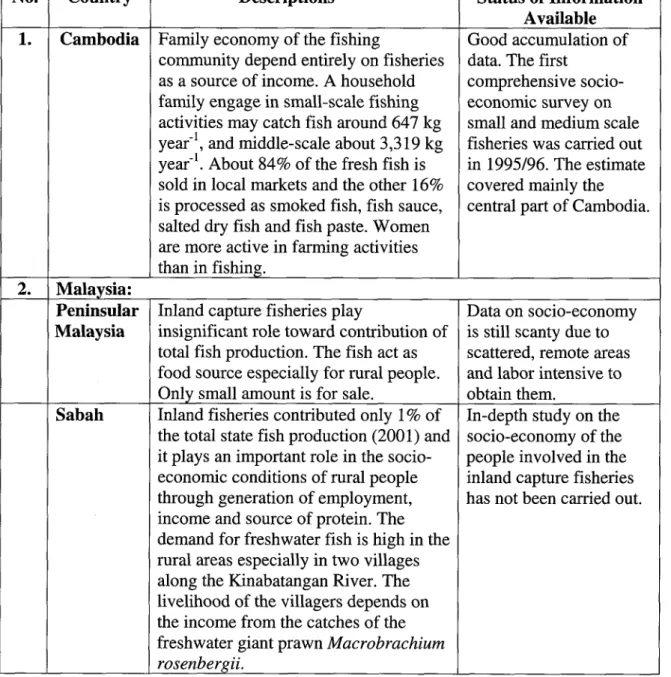
Myanmar Almost all catch are sold in the market or in village after some
Marine fish is difficult and expensive to obtain in these areas and therefore freshwater fish are preferred over fresh or in preserved forms (salted, preserved wet or dried, smoked). It is very unlikely that data will be complete due to the part-time nature of the fishing activities.
Philippines High dependencies on capture fishing as their means of livelihood
Very few statistics are available regarding data on household consumption (eg per capita consumption, percentage of fish in the diet, percentage of catch for sale and actual quantity sold).
Viet Nam Based on the household survey conducted in An Giang province,
- Statistical Data Collection of Inland Fisheries
Proper method of data collection has been carried out at fish markets or landing sites and compiled in the district fisheries offices before being submitted on a monthly basis to the head office in Kota Kinabalu. Sarawak • Since 2001, the Department of Agriculture through its Inland Fisheries Division has initiated proper monthly data collection on freshwater fish landings in selected locations.
Myanmar • Department of Fisheries under Ministry of Livestock
The data is collected in the respective divisional office and then forwarded monthly for collection to the head office. The annual reporting period used its business year, from the first of April to the end of March of the following year.
Philippines • Collection on production by species for inland municipal sector has started in 1977 under the Bureau of Fisheries and
- Inland Fisheries Management System
Sabah • Management is under the responsibility of the State Department of Fisheries through new Fisheries Act: Sabah Inland Fisheries and Aquaculture Act 2003. The Inland Fisheries Department is the implementing arm of the State DoA in all matters relating to inland fisheries and using the Sarawak Inland Fisheries Regulations (SIFR) for regulation.
Myanmar • Ministry of Livestock and Fisheries and Department of Fisheries are the responsible agencies at ministerial and
The development and management of inland water bodies are under the jurisdiction of the respective state governments, which oversee the issuance of permits for inland fishing vessels and equipment. Sarawak • Management falls under the jurisdiction of the Ministry of Agriculture and Food Industry (MAFI), through the Department of Agriculture (DoA).
Philippines • Bureau of Fisheries and Aquatic Resources (BFAR) is the main agency that involved in the conservation and
- List of Publications Available on Inland Capture Fisheries in ASEAN Countries
In Lake Management in the Philippines, Report of the National Symposium Workshop on Lake Fisheries Management, October. Status of the Cambodian Inland Capture Fisheries Sector, with a special focus on the Tonle Sap Great Lake.
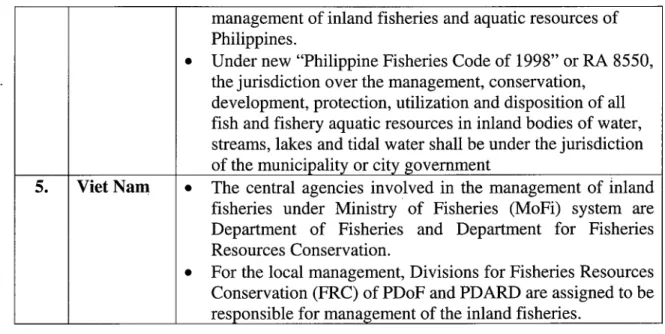
STOCK ENHANCEMENT IN RESERVOIR FISHERIES
OUK VIBOL
- Characteristics of Thmorda Reservoir Fisheries and its Ecology
- An Example of Stock Enhancement in Thmorda Reservoir Fisheries 6.1 Why do we Stock?
- Attitude of Fishers Towards Fish Stocking Programmes
- Lessons Learned from Fish Stocking Programmes
- Recommendations for Further Study
- Reference
Two types of illegal fishing gear used for fishing in the reservoir are electro-fishing (Figure 2) and using very fine mesh nets (Figure 3). The growth of stocked fish in the tank was significantly faster than in the pond.
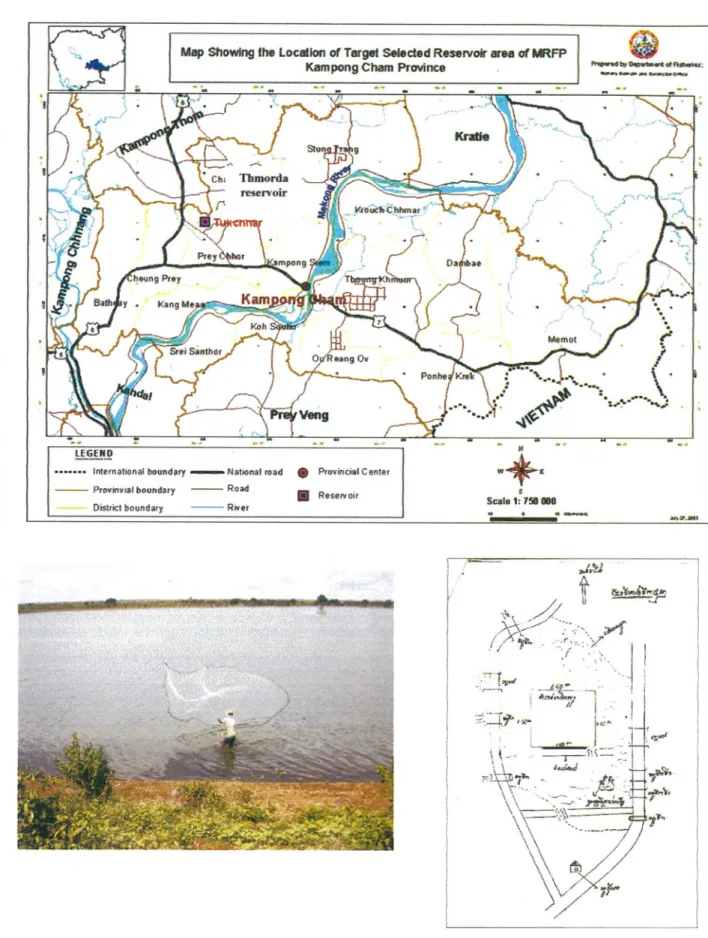
INLAND FISHERY MANAGEMENT IN SONGKRAM RIVER, THAILAND
BOOYARATPALIN, VUDTHIKORN CHITTIWAN AND UBOLRATANA
- Hydrology
- Ecosystems
- Water Quality
- Plankton and Benthos
- Fishery
- Livelihood
- Fish Migrations and Traditional Milk of the Songkhram
- Fishing Ingenuity
- Gender Issues
- Fishery Management
- Conclusion
- Reference
During the flood season, larvae of many species can spread in the large floodplain area of the Songkhram. Enormous ingenuity was demonstrated in the design and construction of fishing gear in the Songkhram River Basin.
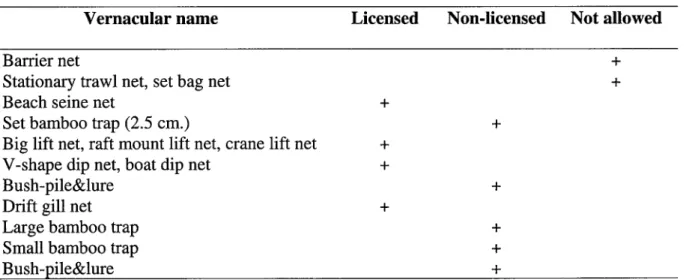
FISHERIES OF INLAND WATER BODIES IN MALAYSIA
- Limnology of Malaysian Reservoirs
- Capture Fisheries
- First Estimates
- Creel Census
- Experimental Fishing
- Electro Fishing
- Acknowledgements
- References
A total of 67 species of fish were caught within the reservoir, compared to only 37 species caught downstream of the reservoir. The northern part of Temengor Reservoir more diverse compared to the southern part of the reservoir.
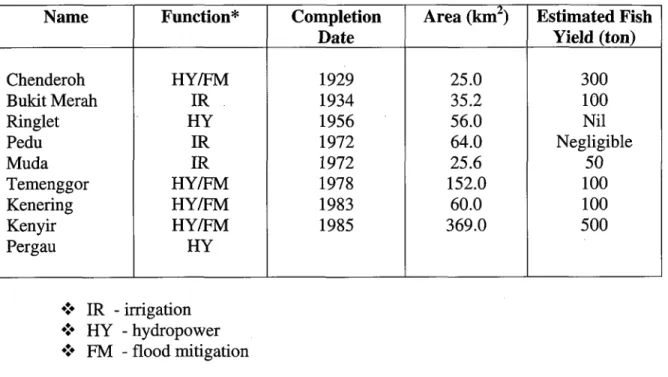
ALTERNATIVE INFORMATION FOR SUPPORTING INLAND FISHERIES
MANAGEMENT AND DECISION-MAKING IN THE SOUTHEAST ASIA
SUGIYAMA, SHUNJI
- Inland Fisheries in the Southeast Asia
- Recent Initiatives
- Policy Aspects
- Institutional Aspects
- Environmental Aspects
- Socio-economic and Cultural Aspects
- Technical Aspects
- Need for New Approaches and Framework for Cooperation
- Breaking the cycle of Inappropriate Knowledge and Low Priority
- Partnership with the Non-fishery Sectors
- Regional Cooperation for Sharing Information and Division of Labor
- New Approaches and Alternative Information
- Use of Agriculture Surveys
- Use of Household Surveys
- Livelihoods Approaches
- Participatory and Co-management Approaches
- Conclusions
These are highly relevant when considering solutions to problems related to inland fisheries data and information collection. Some examples of new approaches to better understanding inland fisheries are given below.
REGIONAL DATABASE SYSTEM AND GIS FOR INFORMATION GATHERING OF
INLAND CAPTURE FISHERIES
SOMBOON SIRIRAKSOPHON, CHANHATAI BOONRAT AND SIRIPORN PANGSORN
System Analysis
In general, in inland capture fisheries, researchers pay attention to four main pieces of information, namely: fishing information, biological information, environmental and social conditions. For fishing information, the main components are fishing species, inland water area, fishing gear and landings.
System Design
Fisheries Information
A country/territory may consist of one inland water area or more, however. For example, in one water_land, which is a relationship between inland water areas and land/area; there is one or more fishing species and these fishing species are caught with one or more types of gear.

Environmental Conditions The parameters are
Biological Information
Socio-economic Information
Data Requirements for GIS
MAHYAM MOHAMMAD ISA
Background and Rationale 2.0 Goals
Objectives
Projects Activities 5.0 Materials and Methods
- Primary Data Collection/ Scientific Data Collection 5.2.2 Secondary Data Collection
Data to be Collected 6.0 Envisaged Outputs
Project Team Members 9.0 Project Schedule for 2003
PROPOSAL FOR PILOT PROJECT
INLAND CAPTURE FISHERIES OF CAMBODIA
- Goals
- Materials and Methods 5.1 Proposed Project Site
- Primary Data Collection
- Secondary Data Collection
- Data to be Collected a) Socio-economic Data
- Envisaged Outputs a) Socio-economic
- Project Team Member
A fisherman will be hired to fish in the area where there is no fishing or the types of fishing gear that are not practiced. Fishing effort inventory regarding the number and types of fishing gear will be examined in each fishing community in the province.
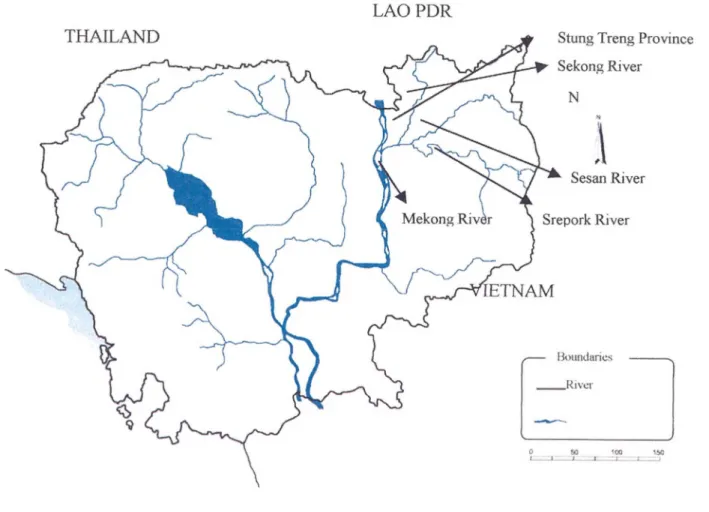
INLAND CAPTURE FISHERIES OF INDONESIA
Background and Rationale
An open water inland fishery in Indonesia has potential to develop as it plays an important role especially for rural people. Exploitation of open water fisheries resources in Indonesia is still low with yield potential).
Project Activities
Establish fishing statistics (catch and value, fishing effort and market) of the study area .. Obtain biological information on commercially important species d) Obtain ecological information on the reservoir.
Envisaged Outputs a) Statistical Data
INLAND CAPTURE FISHERIES OF LAO PDR
PROPOSAL FOR PILOT PROJECT
- Projects Activities
- Proposed Project Site
- Envisaged Outputs
Three main towns in Siphan Done 5.2 Methods of data collection .. a) List of species caught by sampling areas, fishing gear and seasons. Database of inland catch of Siphan Done. f) Recommend an appropriate measurement to manage the fishery.
INLAND CAPTURE FISHERIES OF PENINSULAR MALAYSIA
- Background and rationale
- Methods in Data Collection
- Primary Data Collection/ Scientific Data Collection a. Fish sampling
- Data to be Collected
- Proposed Activities and Budget Requirement for 2003 Source of Funding from Government of Malaysia
- Project Team Members
- Delegations of Responsibilities and Envisaged Outputs
- Primary Data Collection/ Scientific Data Collection a) Fish sampling
- Proposed Activities and Budget Requirement for 2004 Source of Funding from Government of Malaysia
To obtain detailed information on the status of river catfish and clam resources in the Pahang River. Main Pahang River (from the middle part to the lower part of the river in the districts of Temerloh, Maran and Pekan) .. 5.2.2 Primary Data Collection/Scientific Data Collectiona).
INLAND CAPTURE FISHERIES OF SABAH, MALAYSIA
- Materials and Methods 5.1 Proposed Projects Site
- Methods in Data Collection .1 Primary Data Collection
- Data to be Collected
- Proposed Activities and Budget requirement for 2004-2005
- Project Schedule from 2003-2005
To collect as much information on biodiversity, fisheries, environmental conditions and socio-economic conditions of fishermen living along the Kinabatangan River. To collect detailed information on water quality, environmental conditions and sediments affecting the abundance and distribution of fish/larvae in the Kinabatangan River.
INLAND CAPTURE FISHERIES OF SARAWAK, MALAYSIA
List of Projects / Activities
- Study on the Biology and Foods of the Fish Caught
- Socio-economic Survey of Fishers/ Villagers within the Vicinity of Lake
- Ecology of Fish from the Oxbow Lake
- Biology
Section of the lake where the fish are found, time of day they are most caught and other ecological observations. Fry of fish species available at certain times of the year, quantity, habitat type, where fry are found/caught, what time of year.
Proposed Activities and Budget Requirement for 2004-2005 Source of Funding
Project Schedule from Jan 2004- Dec. 2004
INLAND CAPTURE FISHERIES OF MYANMAR
- Data Analysis
- Proposed Activities and Budget Requirement for Three Years Source of Funding
- Inland Fishery Resources and Evaluation of Fishery Management
- Inland Fishing Gears
- Taxonomy of Inland Fishes
Geographical and hydrological conditions at the project sites must be taken on a monthly basis. Ten commercially important species from two project sites are to be selected as main target species.
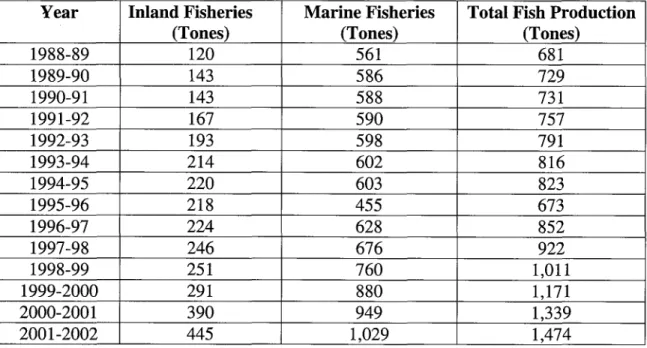
INLAND CAPTURE FISHERIES OF PH IL IPPIN ES
